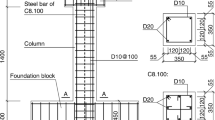Abstract
To ensure the mechanical property of lapped spliced reinforcement and concrete confinement of boundary elements for precast concrete shears, two kinds of constraints, local constraint by additional spiral stirrups placed around each reinforcement splicing and overall constraint by lapped welding closed stirrups replacing traditional stirrups and ties, were proposed in this paper. Low-cyclic reversed loading tests were conducted on three full scale specimens, including one reference cast-in-situ specimen, one precast concrete specimen with local constraint and one precast concrete specimen with overall constraint. By comparing the aspects of strength, stiffness, ductility and energy-dissipation capacity with that of cast-in-situ specimen, it is found that local constraint and overall constraint can be considered equivalent. However, due to the over restraint by local constraint detail, the specimen with local constraint exhibited earlier yielding, poorer energy-dissipation capacity and better ductility than that with overall constraint. Coupled with the consideration of steel usage and construction simplicity, overall constraint detail should be preferred in practical engineering.
Similar content being viewed by others
References
American Concrete Institute (ACI) (2009). Guide to emulating cast-inplace detailing for seismic design of precast concrete structures, ACI, Farmington Hills, MI, p. 2.
American Concrete Institute (ACI) (2011). Building code requirements for structural concrete, ACI, Farmington Hills, MI, p. 230.
Einea, A., Yamane, T., and Tadros, M. K. (1995). “Grout-filled pipe splices for precast concrete construction.” PCI Journal, Vol. 40, No. 1, pp. 82–93.
Henin, E. and Morcous, G. (2015). “Non-proprietary bar splice sleeve for precast concrete construction.” Engineering Structures, Vol. 83, pp. 154–162, DOI: 10.1016/j.engstruct.2014.10.045.
Jansson, P. O. (2008). Evaluation of grout-filled mechanical splices for precast concrete construction, Report No. R-1512, Michigan Department of Transportation, Lansing, MI.
Li, J., Wang, Y., Lu, Z., and Li, J. (2017). “Experimental study and numerical simulation of a laminated reinforced concrete shear wall with a vertical seam.” Applied Sciences-Basel, Vol. 7, No. 6, p. 629, DOI: 10.3390/app7060629.
Li, J., Wang, Y., Lu, Z., and Xia, B. (2018). “Shaking table test and numerical simulation of a superimposed reinforced concrete shear wall structure.” Structural Design of Tall and Special Buildings, Vol. 27, No. 2, p. e1412.
Li, J., Wang, L., Lu, Z., and Wang, Y. (2018). “Experimental study of Lshaped precast RC shear walls with middle cast-in-situ joint.” Structural Design of Tall and Special Buildings, Vol. 27, No. 6, pp. e1457.
Lu, Z., Wang, Z., Li, J., and Huang, B. (2017). “Studies on seismic performance of precast concrete columns with grouted splice sleeve.” Applied Sciences-Basel, Vol. 7, No. 6, p. 571, DOI:10.3390/app7060571.
McLean, D. I. and Smith, C. L. (1997). Noncontact lap splices in bridge column-shaft connections, Report No. WA-RD 417.1, Washington State Department of Transportation, Pullman, Washington.
Oh, Y. H., Han, S. W., and Lee, L. H. (2002). “Effect of boundary element details on the seismic deformation capacity of structural walls.” Earthquake engineering & structural dynamics, Vol. 31, No. 8, pp. 1583–1602, DOI: 10.1002/eqe.177.
Park, R. (1989). “Evaluation of ductility of structures and structural subassemblages from laboratory testing.” Bull. New Zealand Natl. Soc. Earthquake Eng., Vol. 22, No. 3, pp. 155–166.
Thomsen IV, J. H. and Wallace, J. W. (2004). “Displacement-based design of slender reinforced concrete structural walls -experimental verification.” Journal of Structural Engineering, Vol. 130, No. 4, pp. 618–630, DOI: 10.1061/(ASCE)0733-9445(2004)130:4(618).
Wallace, J. W. and Moehle, J. P. (1992). “Ductility and detailing requirements of bearing wall buildings.” Journal of Structural Engineering, Vol. 118, No. 6, pp. 1625–1644, DOI: 10.1061/(ASCE)0733-9445(1992)118:6 (1625).
Wood, S. L., Wight, J. K., and Moehle, J. P. (1987). The 1985 Chile earthquake: observations on earthquake-resistant construction in Viña del Mar, Report UILU-ENG-87-2002, University of Illinois at Urbana-Champaign, Urbana, Illinois.
Yee, A. A. (2001). “Social and environmental benefits of precast concrete technology.” PCI Journal, Vol. 46, No. 3, pp. 14–19.
Author information
Authors and Affiliations
Corresponding author
Rights and permissions
About this article
Cite this article
Zhu, Z., Guo, Z. Seismic Behavior of Precast Concrete Shear Walls with Different Confined Boundary Elements. KSCE J Civ Eng 23, 711–718 (2019). https://doi.org/10.1007/s12205-018-0700-8
Received:
Revised:
Accepted:
Published:
Issue Date:
DOI: https://doi.org/10.1007/s12205-018-0700-8




